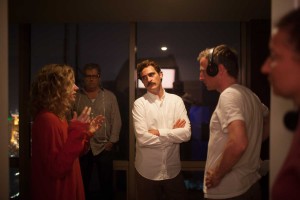
With such wildly diverse approaches as can be found in Being John Malkovich and Adaptation, one of the final summits in director Spike Jonze’s bizarre catalog of films was science-fiction. In the new film Her, an average citizen of a future Los Angeles initiates a relationship with his female-voiced operating system, with art direction by production designer KK Barrett. Given his work on Jonze’s diverse group of films, plus several films by Sofia Coppola, Barrett was hardly in the market for a sci-fi project. “I work from the script and want the director to be attached to that script,” he said of taking on new projects. “I do want it to be a project that comes from the director, and not specifically from the studio as a for-hire assignment. I want to believe in the script.”
Featuring a Los Angeles imagined 10 years from now, with several scenes re-rounded to 2013, Barrett’s assignment was to modify current LA with physical and computer constructions and marry the look with another city, resulting in several exteriors being filmed in Shanghai given its dense urban landscape. Hence, Barrett’s tasks involved “curating and collaging the different parts of the city. We were all over: at the Pacific Design Center in Hollywood, downtown for little bits and scraps. The exterior work was in Shanghai, but you would turn a corner and be in Disney Hall. It was familiar, and something was odd about it and cleaned up about it.”
Keeping most of the scenes above street level provided another window into an imminent future in Southern California. “We tried to take away some recognizable factors and brought buildings [from Shanghai] into our skyline,” Barrett said. “We’re building a city out of images, not hammers and nails and wood. But every location we modified. Some were whole cloth. We heavily modified [lead character Theodore’s] lobby with an elevator built from scratch.”
Conceiving of the future can surely range from the bleak urban blight of Blade Runner to the desolate post-apocalyptic wasteland of Oblivion, and, as such, Barrett worked with Jonze to devise a wholly original construct. “We started out in futurist mode, and we wanted it to be a very comfortable world,” Barrett explained. “It wasn’t a dystopian future. Everything you wanted was there for you except for the struggle of human contact.”
In one scene, Theodore (Joaquin Phoenix) walks from his apartment, gets on a subway, strolls across an exterior concourse into his place of employment and takes an elevator to his office, with that journey revealing the entirety of 2020s LA. “One continuous stream of architecture,” said Barrett. “It’s always what’s fun and entertaining and not like other films. You don’t want something to jump out to be tech-y. We didn’t want anything to have a tech surface or coldness to it. [Jonze] was very wise in realizing that he’s starting to tell a human story.”
While in many digitally-realized films the production designer exits once a team of computer-generated imagery artists take over, Barrett remained involved in the making of Her all the way through postproduction. “It’s been all one team where everyone’s involved,” he said. “We are in a very communal situation. Everyone has their own department to take care of, but interactions with other department heads are extremely valuable.”
Noting that the integration of digital visuals is a tool like any other, Barrett considers digital “as tangible as any physical effect. [The function of] production design is to make something feel like it’s unified.”
Though Barrett concedes that a science-fiction genre component exists in Her [“there is science aspect and a fiction aspect”], he noted that this film is grounded in reality. “It’s the future just a wink away,” he said. “It’s not something that we’re not familiar with. It was very fun, of course, when you get to design the future, but the best decision was not to run away with it, to do something very unique to this world.”
When applauded for making a film whose design is uniform and believable, Barrett was modestly reflective. “That’s what we try for with every film,” he remarked. “One thing can throw the whole thing off. You want everything to sing together and come across as one single experience and is timeless. We wanted to make a film in this time, whatever that time is, and create the bubble for the characters. Other designers all go about the process different ways, but we are all striving for the same thing.”





